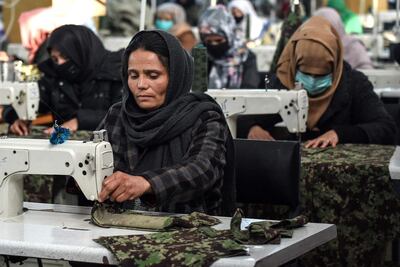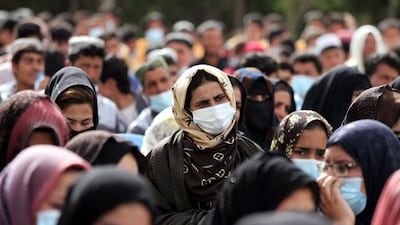Ethnic identity has long been a subject of controversy for some people. But in Afghanistan, it’s only becoming more contentious.
To take one example, a row over the chosen language for the post-2001 national anthem was eventually calmed when it was agreed that the lyrics would mention 14 ethnic groups in the country.
Fifteen years after the song was approved, the number of ethnic groups has exploded to 71.
At least, that’s what a new proposal by the Afghan National Statistics and Information Authority (NSIA) outlines.
The organisation shared a new list classifying Afghan ethnicities and tribes, sparking outrage among citizens, particularly minority groups.
While the list recognises previously marginalised and stateless tribes such as the Jogis, it also breaks down existing minority groups into myriad sub-groups, thereby impacting minority demographics.
"While the distribution of the new ID cards is crucial for improving governance and security, the process has become highly politicised, which in turn has undermined public trust," says Kaweh Kerami, lecturer at American University of Afghanistan (AUA).
"The government, especially NSIA, should have dealt with extreme caution, by not only remaining objective but also legitimising the process through consultations with all stakeholders."
Among those who raised objections was the country’s second Vice President Sarwar Danesh.
"The new list creates a major technical problem in understanding the national demography, and has a negative impact on the identity of minorities," Mohammad Hidayat, Director of Communication and Culture Affairs at the Office of second Vice President Danesh, told The National.
In the current list, the Hazara ethnic group are divided into 13 tribes, however, they all fall under one tribe, he said, which has caused widespread discontent within the community.

“For example, Shekhali is a district, not a tribe. Other examples are Karamali, Kawe, Nikpai and Daimerak. These all fall under the Hazaras, but unfortunately, now they are each a tribe,” Mr Hidayat said, adding that the issue is rather sensitive and could further alienate the persecuted minority.
The second Vice President’s office also stated that the decision was made without any professional study or survey and is an injustice towards the people of Afghanistan.
A spokesperson for the NSAI confirmed to The National that the decisions was not based on academic studies.
"Tribal representatives reached out to different governmental institutions and requested to be added to the list for the e-Tazkira database," said Rohina Shababi, the NSAI spokesperson to The National, referring to the country's electronic national ID program.
“Our intention is not to divide or marginalise any group,” she said, adding that the final list was compiled by the Ministry of Tribal Affairs.
The classifications, however, have earned the ire of the minority communities who have pointed out the breakdown of tribes only applies to ethnic groups other than the Pashtuns, who make up a large section of the Afghan population.
"I feel we are getting excluded from our own community and people day by day, in our own country," Maisam Rezae, a 22-year-old IT student and a resident of Kabul told The National.
Mr Rezae is from the ethnic Hazara minority group who are largely followers of the Shiite sect of Islam, and are often targeted by insurgent groups.
“We have suffered a lot from all these terrorist groups and now on top it all off, our own government who we voted for is dividing us for their political gains,” he added.
The second VP's office echoed these sentiments.
“Historically, it has often been claimed in Afghanistan that the role or representation of any group in the government is defined by their population in the country. And people who believe in this are working to further marginalise the minority groups and their influence in the government,” Mr Hidayat alleged.
In the absence of any census data, the move is seen as an attempt to consolidate the Pashtuns as the largest majority.
Mr Kerami from AUA agrees that the current initiative has become highly politicised.
"In the context of Afghanistan, where the actual size of populations is not known, elites from each group try to shape certain narratives to boost their bargaining positions. This also exhibits itself in government agencies, where appointments are largely political.”
This isn’t the first time ethnic issues have spurred national debate on the population demographics. Mr Kerami says that the legacy of colonial rule “contributed to the politicisation of ethnicity.”
“Regrettably, the Central Statistics Authority of Afghanistan has recently attempted to divide the ethnic groups of Afghanistan into villages and districts, based on a pre-orchestrated agenda,” said Salahuddin Rabbani, former Minister and the current leader of Jamiat-e-Islami, a largely Tajik political.
“This action is a continuation of the steps that have been taken for some time now by a small select group in order to undermine the political system, provoke ethnic strife and fragment a united Afghanistan,” he said.
Mr Hidayat recommended that that the Afghan government undertake an academic study to re-evaluate the list.
“We suggest the creation of a new committee or utilising the expertise of existing committees created by the President a few years ago, and include academics, sociologists, anthropologists and historians to study and debate Afghan demographics before adding tribes and sub-tribes based on individual requests.”
“Otherwise, we will be adding 50 new tribes every day for every clan who wants to be identified as a tribe,” he said.
Mr Rezae also urged the government to maintain unity during such crucial times, when the future of the country’s security and progress is being discussed in an ongoing negotiation with the Taliban.
“Now is the time for solidarity and unity. History has taught us that division has never been a solution,” he said.

